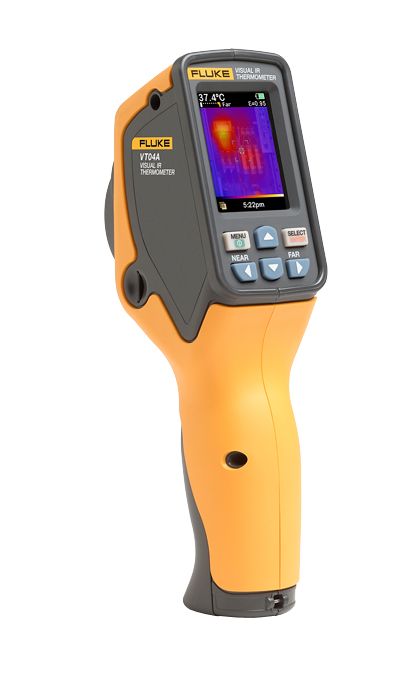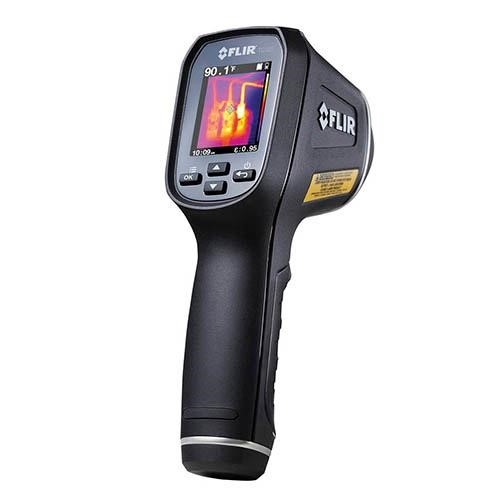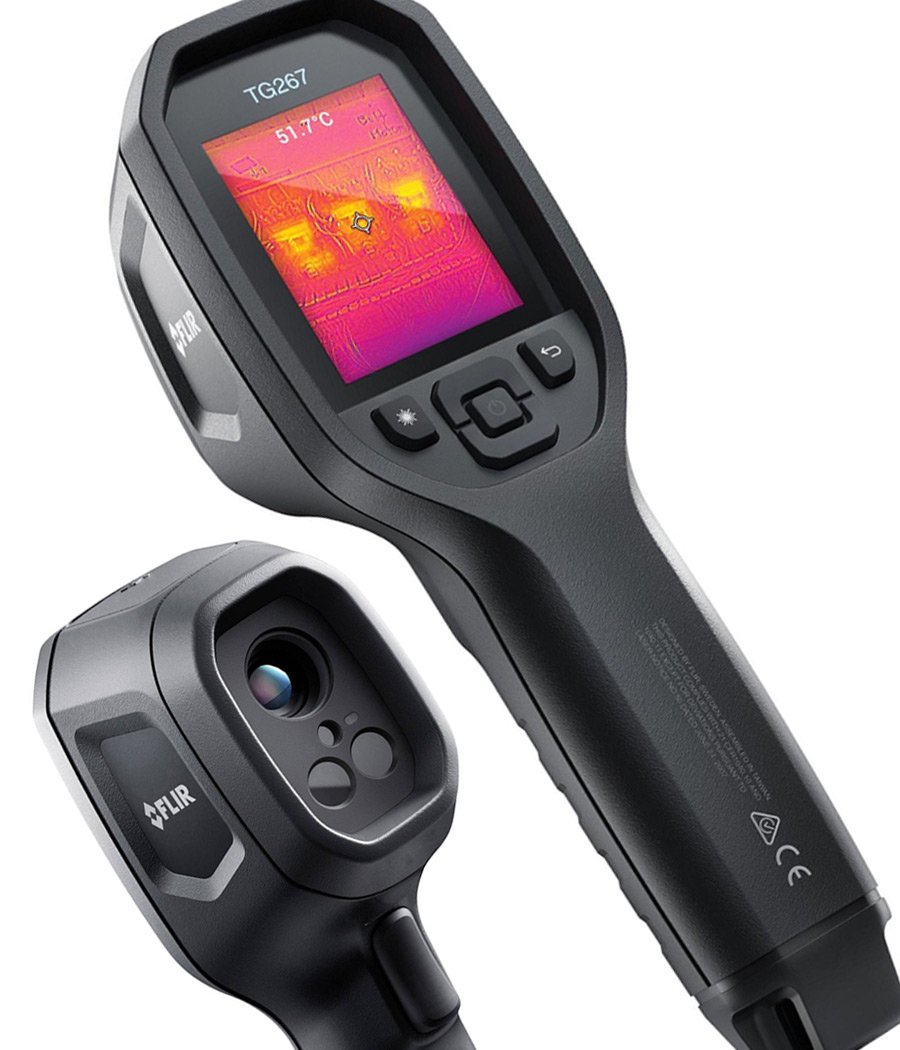PROS: Long battery life (8 hours), Thermal & Visual image blending
CONS: IR resolution is low, temperature range could be wider, small LCD, no thermal data is stored in the images
| Product | Type | Resolution | Battery capacity | Waterproof | LCD screen | Price |
|---|---|---|---|---|---|---|
Fluke VT04  | Handheld | 31 x 31 | 8 hours | No | 2″ | Click for more info |
Flir TG165-X  | Handheld | 80 x 60 | 5 hours | Yes | 2.4″ | Click for more info |
FLIR TG267  | Handheld | 160 x 120 | 5 hours | Yes | 2.4″ | Click for more info |
Fluke VT04 Specifications
| Type | Handheld |
|---|---|
| Resolution | 31 x 31 |
| Pixels | 961 |
| Connectivity | USB (Micro-USB) |
| Temperature range | 14° F to 482°F (-10° to 250°C) |
| Accuracy | +/- 2 ° C |
| Thermal sensitivity | 0.25°C |
| Distance | |
| Storage Type | SD card |
| Battery capacity | 8 hours |
| Dimensions | 13 x 3 x 24 inches |
| LCD screen | 2″ |
| Refresh rate | 8 HZ |
| Applications | Electrical, HVAC, Mechanical, Building, Roofing, Electrical Inspection, Automotive diagnostics |
| View Angle | 28° x 28° |
Fluke VT04 – Specs & Review
The Fluke VT04 is a visual IR thermometer and we say that because it is not a full radiometric thermal camera and thus it doesn’t store temperature data for every pixel in the thermal image. They are one of the only companies to clearly state what their product is. There are a number of cases in which companies have branded their IR thermometers as thermal imaging cameras which they are not.
That being said, it is a pretty good Visual IR thermometer. On the back it has an infrared sensor coupled together with a visible light camera. The device itself also has Micro USB connectivity so you can easily download the captured images.
In terms of build quality, the rubberized parts feel great, but the plastic on the bottom feels cheap. The buttons feel great and they are big enough to be easily pressed. If we only look at the datasheet and the specs, things don’t look great and so let’s look at real world usage.
The start-up time is about 20 seconds and that includes you having to switch to the camera mode, since it always starts in the settings menu.
Another annoying thing about the Fluke is that every time you take a picture it asks you if you want to save it to the SD card, however it doesn’t display the picture for you to take your time and decide.
When you are using the camera to take pictures, you will see on your screen the center spot thermal measurement and also the hottest point and coldest point in the image. What is interesting is that the device doesn’t display the temperature of the last two, it just marks the spots.
You can choose to overlay the 2 images in 4 modes (0%, 25%, 50% or 75% thermal). Another great feature is the high/low temperature alarms which flash when the temperature either drops below a certain threshold or rises above one. Alongside the alarm, the thermal camera has a timelapse feature in which it captures an image at a specified interval. Another potentially useful feature (I haven’t found the use case for it yet) is the ability to capture an image when the measured temperature reaches a certain value. You can also adjust the emissivity and the rule of thumb there is the shinier the material, the lower the emissivity.
On the front of the VT04 you will find two buttons for calibration labeled Near and Far, which help with image registration. So to quickly align the thermal and visual images you use those two buttons.
Fluke VT04 – Thermal imaging quality
Let’s start by looking at the thermal image quality of this infrared camera. The infrared resolution is lower that Lil Jon’s song. With a 31 x 31 resolution, it only manages to total 961 pixels in the image. Now at this point I feel it is my duty to point out that other cameras that with this price tag offer 32,136 pixels, so 30 times more pixels.
But if this seems bad, don’t leave just yet because the Fluke VT04 infrared imager also a visual camera, so the two images are blended together in a more high-resolution image and that makes the details much more distinguishable while displaying the warmer and colder areas. It is not as good as Flir’s MSX image enhancement technology, but nevertheless it makes a big difference.
The images are stored in BMP format or IS2 format (You can open that file using SmartView) To keep the two images aligned you need to always make sure that they are properly aligned depending on the distance from which you are measuring. The live view has an 8Hz refresh rate and the camera doesn’t have any kind of manual focus.
Fluke VT04 – Temperature Range, Accuracy
In terms of thermal sensitivity, the camera does not fare that well either with a 0.25°C sensitivity. Other cameras in its class offer 0.07°C, a far better value. Just in case you are new to the field, this value represents how much the temperature has to change in order for the thermal imaging device to detect a change in temperature and adjust its measurement.
There is also the issue of temperature measurement accuracy and here the Fluke VT04 does well with a +/-2° C accuracy. The temperature range is decent, but that could be better as well. You can measure between 14° F to 482°F (-10° to 250°C). This is going to be ok for most cases like home inspections, plumbing or electrical faults like fuses that overheat. However do not expect it to be usable in troubleshooting freezers, refrigeration equipment or high temperature machinery like ovens.
It does however have a wide viewing angle with a 28° x 28° field of view, a very narrow one which is useful for inspecting issues close up.
Fluke VT04 – Battery life & Memory
In terms of storage, the Fluke VT04 has an SD card slot and the package includes a 4GB SD card. Fluke states you can store 10,000 images on every GB of storage but that is because the images don’t have any thermal data in them. So in terms of storage it fares very well especially since it has memory card support, something that most Flir models lack.
If things didn’t look very spectacular, wait until we get to the battery. Its internal Lithium-Ion battery can last up to 8 hours of battery life. Its battery life blows away the competition which usually sits at 5 hours in this price class. Even if you buy the Fluke VT04A which uses 4 AA batteries, you still get the 8 hour battery life, meaning this is a very energy-efficient device.
The thermal imager is not waterproof or dustproof and here, Fluke could have made a big difference by building this product to get a decent IP rating. There are not many thermal cameras that can do that and a camera being waterproof is at least a good selling point.
The camera has a 2″ color LCD screen. For this budget, we would have expected at least a 3″ color screen.
We like the carrying case in which it comes and the contents, it looks very professional. In the package you get the camera itself, the included SD Card, the charger together with adapters for US, EU, UK plugs, a USB cable and the Smartview Software on a CD. The SmartView software allows you to create reports, inspect the images and you can also adjust the blending mode of the thermal and visual images (It is not limited to 25%, 50% and 75%, you can actually do very fine adjustments).
And finally we get to warranty where things look great, because Fluke offers a 2 year warranty for this thermal imaging device. What we like is that you can do a firmware update and Fluke provides an updated firmware on their website. You just need the Fluke USB driver to connect it to your PC which you’ll find on their website.
Fluke also provides an electrical combo kit, the Fluke VT04-ELEC-KIT that includes a Fluke IR thermometer, a clamp meter and a multimeter. You’ll find it under the part number: “flk-vt04-elec-kit” To conclude our review, we think that this handheld thermal camera is great for the home user, for a simple building inspection, but not more. There are better options out there for sale on Amazon and eBay like the Flir TG165.
